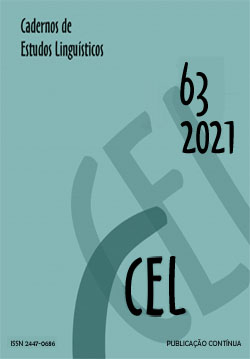Resumo
Este trabalho investiga o sincretismo da morfologia passiva em latim. Nessa língua, o sufixo que realiza a voz passiva (default: -r) também é encontrado em construções impessoais, anticausativas, contextos médios e verbos depoentes. Parte-se dos trabalhos de Schäfer (2008) e Lazzarini-Cyrino (2015) e, sob o modelo da Morfologia Distribuída (HALLE & MARANTZ, 1993; MARANTZ, 1997), apresenta-se uma proposta de derivação que postula que a marca sincrética é um argumento verbal não referencial – uma variável – incorporado ao verbo pós-sintaticamente. Os diversos contextos interpretativos em que a marca aparece resultam da posição original que esse argumento ocupava e da sua interação com diferentes sabores de Voice (FOLLI & HARLEY, 2005). Sendo a variável um argumento externo, não há outro DP para ela se ligar, e ela fica sem papel-θ e Caso. Sem papel-θ, a variável é lida como um expletivo em LF. A ausência de Caso, por sua vez, é um problema para PF (LEVIN, 2015) e, para que a derivação não seja perdida, a variável se incorpora ao domínio verbal via Deslocamento Local, nos termos de Levin (2015). A voz passiva e os impessoais resultam da incorporação da variável na posição de argumento externo de um VoiceDO. A mesma configuração, mas com um VoiceCAUSE, gera os anticausativos. Nos contextos médios, a variável também nasce na posição de argumento externo, mas é o argumento de um núcleo Appl (PYLKKÄNEN, 2008) que é promovido a sujeito sintático. Os depoentes se dividem em três tipos: propõe-se que os agentivos são, em verdade, médios, sendo derivados como eles; os depoentes de sujeitos experienciadores projetam esse argumento via um núcleo específico que chamamos de EXP e a variável ocupa a posição de argumento externo canônico; depoentes anticausativos resultam da incorporação do argumento de Appl ou EXP, mas em uma estrutura sem Voice.
Referências
ALEXIADOU, Artemis. Where is non-active morphology. Proceedings of the 20th conference on Head-driven phrase structure grammar, p. 244-262, 2013.
ALEXIADOU, Artemis; ANAGNOSTOPOULOU, Elena; SCHÄFER, Florian. The properties of anticausatives crosslinguistically. Phases of interpretation, v. 91, p. 187-211, 2006.
BAKER, Mark C. Incorporation: A theory of grammatical function changing. 1988.
CARVALHO, Janayna Maria da Rocha. A morfossintaxe do português brasileiro e sua estrutura argumental: uma investigação sobre anticausativas, médias, impessoais e a alternância agentiva. Tese de Doutorado. Universidade de São Paulo, 2016.
EMBICK, David. Unaccusative syntax and verbal alternations. In: ANAGNOSTOPOULOU, Elena; ALEXIADOU, Artemis; EVERAERT, Martin (eds.). The unaccusativity puzzle: Explorations of the syntax-lexicon interface, Oxford University Press, p. 137-158, 2004.
EMBICK, David. The morpheme: A theoretical introduction. Walter de Gruyter GmbH & Co KG, 2015.
EMBICK, David; NOYER, Rolf. Movement operations after syntax. Linguistic inquiry, v. 32, n. 4, p. 555-595, 2001.
EMBICK, David; NOYER, Rolf. Distributed morphology and the syntax/ morphology interface. In: RAMCHAND, Gillian; REISS, Charles (eds.) The Oxford handbook of linguistic interfaces, p. 289-324, 2007.
FARIA, Ernesto. Gramática superior da língua latina. Livraria Acadêmica, 1958.
FOLLI, Raffaella; HARLEY, Heidi. Flavors of v. In: FOLLI, Raffaella; HARLEY, Heidi; KEMPCHINSKY, Paula; SLABAKOVA, Roumyana (eds.) Aspectual inquiries, p. 95-120. Springer, Dordrecht, 2005.
HALLE, Morris; MARANTZ, Alec. Distributed morphology and the pieces of inflection. In: BROMBERGER, Sylvain (ed.). The View from Building 20: Essays in linguistics in honor of Sylvain Bromberger, p. 111-176, 1993.
HARLEY, Heidi. Getting morphemes in order: Merger, affixation, and head movement. Diagnosing syntax, p. 44-74, 2011.
HARLEY, Heidi; NOYER, Rolf. Formal versus encyclopedic properties of vocabulary: Evidence from nominalizations. The lexicon-encyclopedia interface, p. 349-374, 2000.
HEINAT, Fredrik. Why phrases probe. The Department of English in Lund: Working Papers in Linguistics, v. 5, p. 33-63, 2005.
HEINAT, Fredrik. Probes, pronouns, and binding in the minimalist program. The Department of English in Lund: Working Papers in Linguistics, v. 6, p. 19-37, 2006.
HEINAT, Fredrik. Binding condition C and derivation by phase. Manninen & Paradis, 2002.
KEMMER, Suzanne. The middle voice. John Benjamins Publishing, 1993.
KRATZER, Angelika. Severing the external argument from its verb. In: ROORYCK, Johan; ZARING, Laurie (eds.) Phrase structure and the lexicon, p. 109-137. Springer Science & Business Media, 1996.
LAZZARINI-CYRINO, João Paulo. O sincretismo passivo-reflexivo: um estudo translinguístico. Tese de Doutorado. Universidade de São Paulo, 2015.
LEVIN, Theodore Frank. Pseudo noun incorporation is M-Merger: evidence from Balinese. LSA Annual Meeting Extended Abstracts, p. 18-1-5, 2014.
LEVIN, Theodore Frank. Licensing without case. PhD dissertation. MIT, 2015.
MARANTZ, Alec. No escape from syntax: Don't try morphological analysis in the privacy of your own lexicon. University of Pennsylvania Working Papers in Linguistics, v. 4, n. 2, p. 14, 1997.
MASSAM, Diane. Pseudo noun incorporation in Niuean. Natural Language & Linguistic Theory, v. 19, n. 1, p. 153-197, 2001.
NOYER, Rolf. Features, Positions and Affixes in Autonomous Morphological Structure. Garland Publishing, New York, 1997.
ÖZTURK, Balkiz. Pseudo-incorporation of agents. University of Pennsylvania Working Papers in Linguistics, v. 11, n. 1, p. 17, 2005.
PESETSKY, David Michael. Zero syntax: Experiencers and cascades. MIT press, 1996.
PREMIGER, Omer. Agreement as a fallible operation. PhD dissertation, MIT, 2011.
PYLKKÄNEN, Liina. Introducing arguments. MIT press, 2008.
SAAB, Andres. Deconstructing Voice: The syntax and semantics of u-syncretism in Spanish. 2020.
SCHÄFER, Florian. The syntax of (anti-) causatives: External arguments in change-of-state contexts. John Benjamins Publishing, 2008.
TRAVIS, Lisa de Mena. Parameters and effects of word order variation. PhD dissertation. MIT, 1984.
XU, Zheng; ARONOFF, Mark; ANSHEN, Frank. Deponency in Latin. Proceedings of the British Academy. Oxford University Press Inc., 2007.

Este trabalho está licenciado sob uma licença Creative Commons Attribution-NonCommercial 4.0 International License.
Copyright (c) 2021 Cadernos de Estudos Linguísticos


